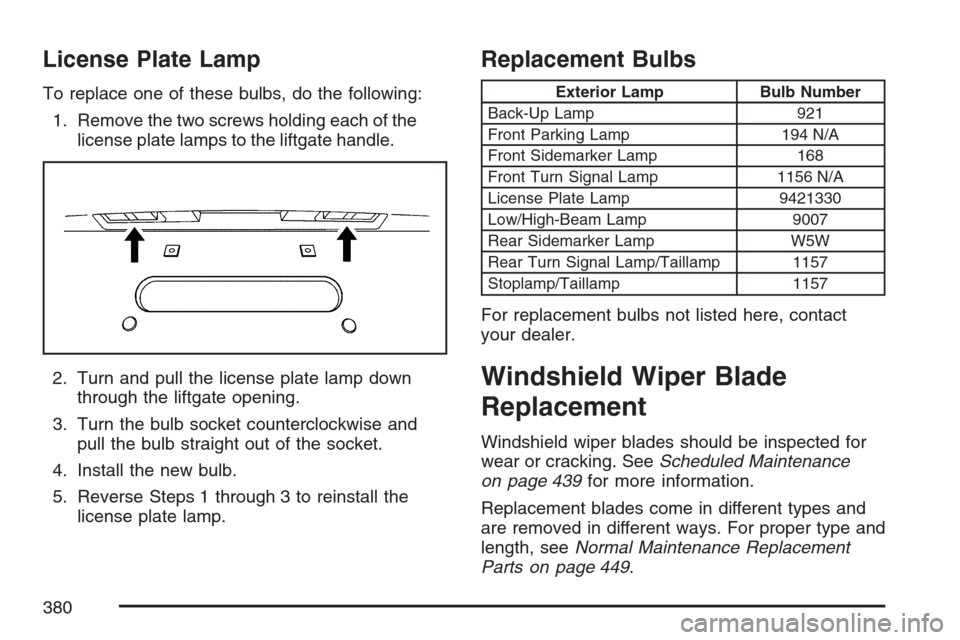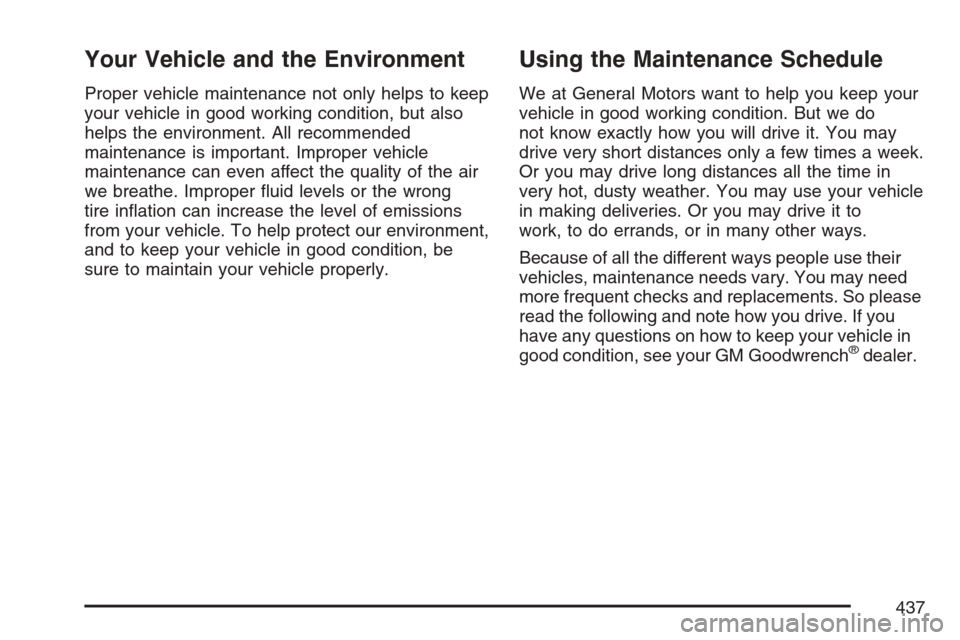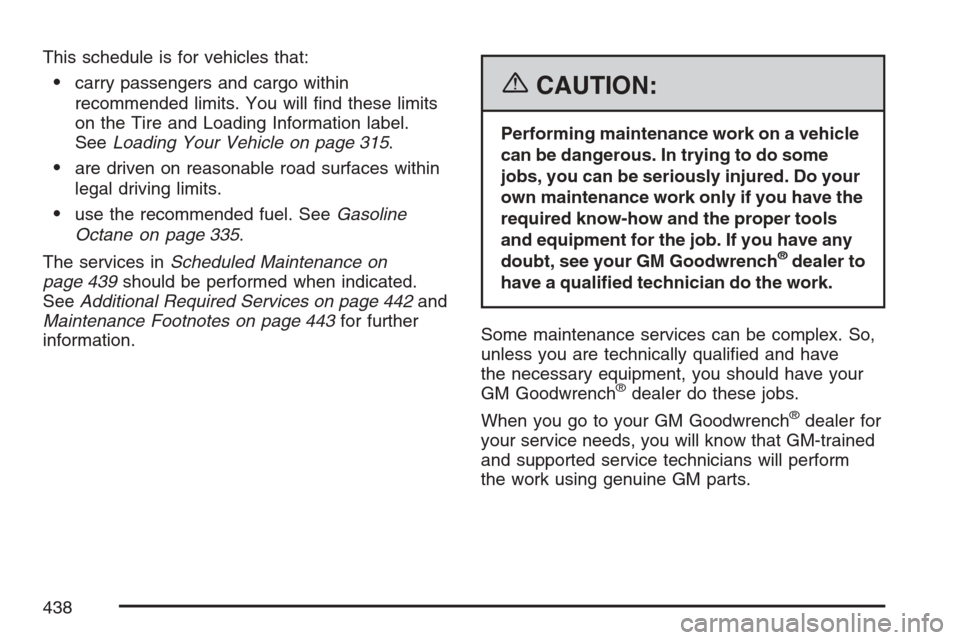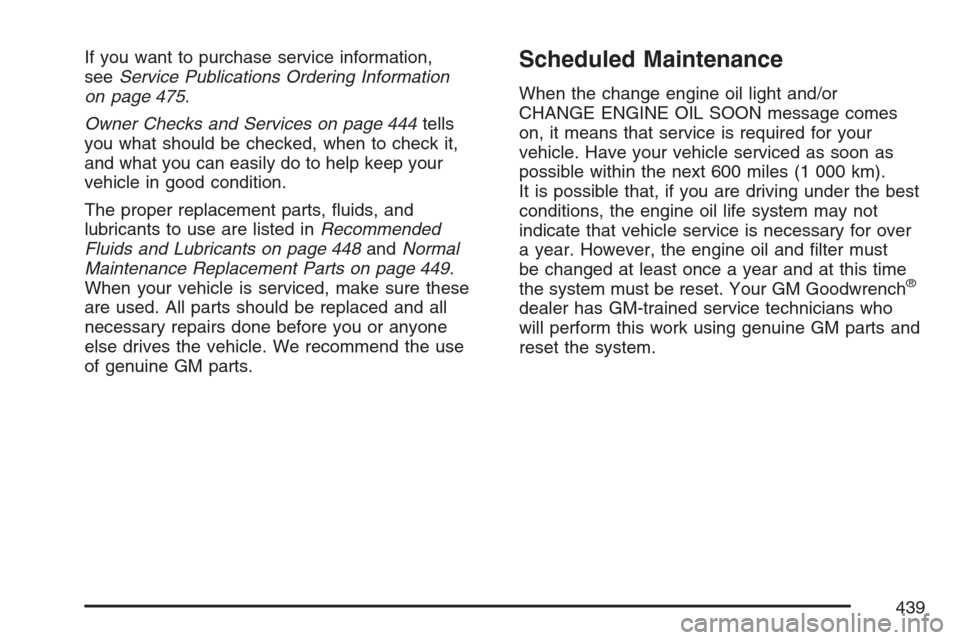Page 375 of 492
Carrier Assembly-Differential
(Rear Drive Module)
When to Check and Change Lubricant
Refer to the Maintenance Schedule to determine
how often to check the lubricant and when to change
it. SeeScheduled Maintenance on page 439.
How to Check Lubricant
A. Fill Plug
B. Drain PlugTo get an accurate reading, the vehicle should be
on a level surface.
If the level is below the bottom of the �ller plug
hole, you’ll need to add some lubricant. Add
enough lubricant to raise the level to the bottom of
the �ller plug hole. A �uid loss could indicate a
problem; check and have it repaired, if needed.
What to Use
Refer to the Maintenance Schedule to determine
what kind of lubricant to use. SeeRecommended
Fluids and Lubricants on page 448.
Bulb Replacement
For the proper type of replacement bulbs, see
Replacement Bulbs on page 380.
For any bulb changing procedure not listed in this
section, contact your dealer.
AWD Differential Case
375
Page 380 of 492

License Plate Lamp
To replace one of these bulbs, do the following:
1. Remove the two screws holding each of the
license plate lamps to the liftgate handle.
2. Turn and pull the license plate lamp down
through the liftgate opening.
3. Turn the bulb socket counterclockwise and
pull the bulb straight out of the socket.
4. Install the new bulb.
5. Reverse Steps 1 through 3 to reinstall the
license plate lamp.
Replacement Bulbs
Exterior Lamp Bulb Number
Back-Up Lamp 921
Front Parking Lamp 194 N/A
Front Sidemarker Lamp 168
Front Turn Signal Lamp 1156 N/A
License Plate Lamp 9421330
Low/High-Beam Lamp 9007
Rear Sidemarker Lamp W5W
Rear Turn Signal Lamp/Taillamp 1157
Stoplamp/Taillamp 1157
For replacement bulbs not listed here, contact
your dealer.
Windshield Wiper Blade
Replacement
Windshield wiper blades should be inspected for
wear or cracking. SeeScheduled Maintenance
on page 439for more information.
Replacement blades come in different types and
are removed in different ways. For proper type and
length, seeNormal Maintenance Replacement
Parts on page 449.
380
Page 396 of 492
Tire Inspection and Rotation
Tires should be rotated every 5,000 to 8,000 miles
(8 000 to 13 000 km).
Any time you notice unusual wear, rotate your
tires as soon as possible and check wheel
alignment. Also check for damaged tires or wheels.
SeeWhen It Is Time for New Tires on page 397
andWheel Replacement on page 402for
more information.
The purpose of regular rotation is to achieve more
uniform wear for all tires on the vehicle. The �rst
rotation is the most important. SeeScheduled
Maintenance on page 439for scheduled rotation
intervals.When rotating your tires, always use the correct
rotation pattern shown here.
Do not include the compact spare tire in your
tire rotation.
After the tires have been rotated, adjust the
front and rear in�ation pressures as shown on
the Tire and Loading Information label. See
In�ation - Tire Pressure on page 390and
Loading Your Vehicle on page 315.
396
Page 435 of 492
Maintenance Schedule................................ 436
Introduction............................................... 436
Maintenance Requirements........................ 436
Your Vehicle and the Environment............ 437
Using the Maintenance Schedule............... 437
Scheduled Maintenance............................. 439
Additional Required Services..................... 442
Maintenance Footnotes.............................. 443Owner Checks and Services..................... 444
At Each Fuel Fill....................................... 445
At Least Once a Month............................. 445
At Least Once a Year............................... 446
Recommended Fluids and Lubricants........ 448
Normal Maintenance Replacement Parts..... 449
Engine Drive Belt Routing......................... 450
Maintenance Record.................................. 451
Section 6 Maintenance Schedule
435
Page 436 of 492
Maintenance Schedule
Introduction
Important: Keep engine oil at the proper level
and change as recommended.
Have you purchased the GM Protection Plan? The
Plan supplements your new vehicle warranties.
See your Warranty and Owner Assistance booklet
or your dealer for details.
Maintenance Requirements
Notice:Maintenance intervals, checks,
inspections, replacement parts, and
recommended �uids and lubricants as
prescribed in this manual are necessary to
keep your vehicle in good working condition.
Any damage caused by failure to follow
scheduled maintenance may not be covered
by warranty.
436
Page 437 of 492

Your Vehicle and the Environment
Proper vehicle maintenance not only helps to keep
your vehicle in good working condition, but also
helps the environment. All recommended
maintenance is important. Improper vehicle
maintenance can even affect the quality of the air
we breathe. Improper �uid levels or the wrong
tire in�ation can increase the level of emissions
from your vehicle. To help protect our environment,
and to keep your vehicle in good condition, be
sure to maintain your vehicle properly.
Using the Maintenance Schedule
We at General Motors want to help you keep your
vehicle in good working condition. But we do
not know exactly how you will drive it. You may
drive very short distances only a few times a week.
Or you may drive long distances all the time in
very hot, dusty weather. You may use your vehicle
in making deliveries. Or you may drive it to
work, to do errands, or in many other ways.
Because of all the different ways people use their
vehicles, maintenance needs vary. You may need
more frequent checks and replacements. So please
read the following and note how you drive. If you
have any questions on how to keep your vehicle in
good condition, see your GM Goodwrench
®dealer.
437
Page 438 of 492

This schedule is for vehicles that:
carry passengers and cargo within
recommended limits. You will �nd these limits
on the Tire and Loading Information label.
SeeLoading Your Vehicle on page 315.
are driven on reasonable road surfaces within
legal driving limits.
use the recommended fuel. SeeGasoline
Octane on page 335.
The services inScheduled Maintenance on
page 439should be performed when indicated.
SeeAdditional Required Services on page 442and
Maintenance Footnotes on page 443for further
information.
{CAUTION:
Performing maintenance work on a vehicle
can be dangerous. In trying to do some
jobs, you can be seriously injured. Do your
own maintenance work only if you have the
required know-how and the proper tools
and equipment for the job. If you have any
doubt, see your GM Goodwrench
®dealer to
have a quali�ed technician do the work.
Some maintenance services can be complex. So,
unless you are technically quali�ed and have
the necessary equipment, you should have your
GM Goodwrench
®dealer do these jobs.
When you go to your GM Goodwrench
®dealer for
your service needs, you will know that GM-trained
and supported service technicians will perform
the work using genuine GM parts.
438
Page 439 of 492

If you want to purchase service information,
seeService Publications Ordering Information
on page 475.
Owner Checks and Services on page 444tells
you what should be checked, when to check it,
and what you can easily do to help keep your
vehicle in good condition.
The proper replacement parts, �uids, and
lubricants to use are listed inRecommended
Fluids and Lubricants on page 448andNormal
Maintenance Replacement Parts on page 449.
When your vehicle is serviced, make sure these
are used. All parts should be replaced and all
necessary repairs done before you or anyone
else drives the vehicle. We recommend the use
of genuine GM parts.Scheduled Maintenance
When the change engine oil light and/or
CHANGE ENGINE OIL SOON message comes
on, it means that service is required for your
vehicle. Have your vehicle serviced as soon as
possible within the next 600 miles (1 000 km).
It is possible that, if you are driving under the best
conditions, the engine oil life system may not
indicate that vehicle service is necessary for over
a year. However, the engine oil and �lter must
be changed at least once a year and at this time
the system must be reset. Your GM Goodwrench
®
dealer has GM-trained service technicians who
will perform this work using genuine GM parts and
reset the system.
439